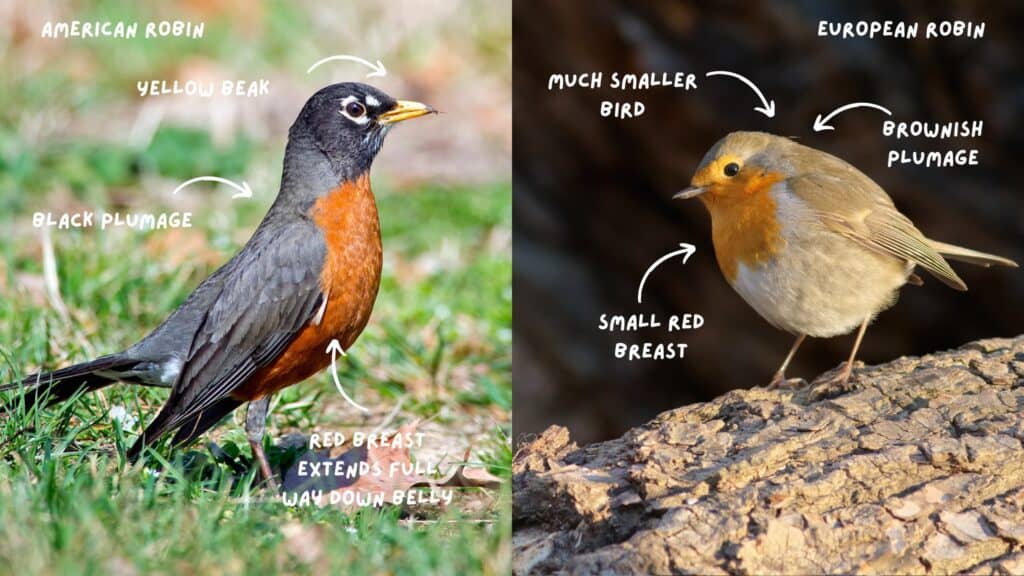Undoubtedly one of the UK most popular birds and one of the easiest to identify is the Robin. This cheery visitor to our gardens likes nothing better than to perch close by while you till the soil, producing worms, insects and other tasty morsels which the robin would otherwise struggle to obtain. But have you ever wondered how long a Robin lives?
Generally speaking, the European robin or robin redbreast has a very high mortality rate, with as few as 1 in 4 birds surviving their first year and the life expectancy of a Robin is estimated to be around 1½ years. Once a bird passes this initial milestone, the chances of survival increase and some birds are known to have lived well over 10 years. In contrast, the American robin is known to live for around 2 years.
There are more than one type or species of robin and some distinct differences between them. The American robin (Turdus migratorius) is a large North American thrush often found in the Eastern United States, and the European robin (Saxicolinae) is much smaller and found across the UK and Europe.
Continue reading to find out the key differences between the American robin vs the European, including whether their lifespan is the same.
Why do robins live for only a year?
Robins are small birds, which means they have little fat reserves to survive extended periods of freezing weather. Much like other small birds, robins must take on sufficient food during the day to survive the cold or freezing temperatures during the night and need to eat around one-third of their body weight during the day to survive the night.
Robins are primarily ground feeders, and freezing temperatures can make survival extremely difficult, requiring the robin to spend most of its time searching for food. Although robins are known to frequent bird feeders, they are predominantly ground feeders, and prolonged periods of freezing weather or snow prevent the robin from reaching its natural food sources. Sadly, unless robins are successful at obtaining adequate food during the day, it is unlikely they will survive the night, and this is why so many robins rarely live longer than 1-2 years.
During the winter months, robins and many other wild birds will take full advantage of any food placed on a feeder, as it can be a matter of life or death for them. Robins are territorial, but in times of freezing weather, robins are more tolerant of other robins that may share the same food and water source. The importance of survival deemed more important than expending energy of fighting over territory. In addition to affecting food sources, freezing weather can also lead to a shortage of drinking water due to natural sources freezing quickly.
Placing a water source close by to your feeder will greatly benefit wild birds but remember that water placed outside in freezing temperatures will also freeze after a short time, and it should be checked regularly.
Do robins migrate?
Robins are resident in the UK throughout the year, and the vast majority do not migrate. However, of those that do, many are female and migrate to warmer parts of Europe, with some even recorded as far south a Spain and Portugal. Interestingly, robins from these locations are paler in appearance and have a greater distrust of humans, resulting from many of the birds coming from woodland locations where contact with humans is less.
Robins from other parts of Europe, Scandinavia and Russia are known to migrate to the UK in the autumn, shortly before temperatures plummet. In recent years, however, the UK has also experienced some very prolonged periods of cold weather, resulting in these small birds having an equally tough time. In the January of 2021, the UK experienced the coldest weather for 10 years, with day temperatures averaging 2.2C and night temperature dropping below -10. In Braemar, Aberdeenshire, the mercury dropped as low as -22.9C.
Aside from the resident UK robin and its European cousin, the American robin is distinctly different.
What is the difference between the UK and American robin?
In contrast to the UK/European robin, the American robin is considerably larger than its UK/European namesake.

| Figures | American Robin | European Robin |
| Length | 20-28 cm | 14 cm |
| Wingspan | 31-40 cm | 20-22 cm |
| Weight | 77-85 g | 14-21 g |
| Food | Insects, spiders, worms,fruit | Insects, spiders, worms, fruit |
Although both are referred to as robins, the American robin is actually a member of the thrush family and, aside from sharing a red breast, is not particularly related to the European robin. The thrush family comprises over 300 species and tends to be relatively uniform in size and shape. The size of the American robin is notably different, with length, wingspan and weight being considerably greater than the European robin. The distinctive redbreast is also somewhat different, with the American robin displaying a darker, almost copper breast compared to the softer orange of the European robin.
Both the American and European robins share a similar diet of Insects, spiders, worms and fruit and choose to inhabit similar locations. In both American and UK/European species, the males and females look very much the same, although the American female robin is noted to have a slightly lighter shade of red than the male.
Much like the UK/European robin, the American robin is common across the US and enjoy similar habitats, found in gardens, parks, golf courses, fields and woodland, but those found in the west tend to be slightly paler in appearance than those in the east.
Both the male and female of UK/European and US robins appear the same so it can be difficult to an untrained eye to tell the difference.
How long do other birds live?
Here is a table of the approximate life span of 29 of the most common UK birds.
| Species | Approximate Life Span (Years) |
| Blackbird | 2.5 |
| Blackcap | 2 |
| Bluetit | 2 |
| Carrion Crow | 4 |
| Chaffinch | 3 |
| Coal Tit | 2 |
| Collared Dove | 3 |
| Dunnock | 2 |
| Great Tit | 3 |
| Greenfinch | 2 |
| Green Woodpecker | 10 |
| Goldcrest | 1 |
| Goldfinch | 2 |
| House Martin | 2 |
| House Sparrow | 3 |
| Jay | 2 |
| Long Tailed Tit | 2 |
| Magpie | 3 |
| Marsh Tit | 2 |
| Nuthatch | 2 |
| Redpoll | 2 |
| Robin | 2 |
| Siskin | 3 |
| Song Thrush | 3 |
| Spotted Woodpecker | 11 |
| Starling | 2.5 |
| Turtle Dove | 2 |
| Wren | 2 |
| Wood Pigeon | 5 |
Other related question asked
How long do blackbirds live? The life expectancy of a blackbird is approximately 2-3 years, although many have been known to live for much longer, with some estimated to be around 10+ years.
How long do sparrows live? The life expectancy of both the tree sparrow and the house sparrow is approximately 3 years, although some may live as long as 5 years.
